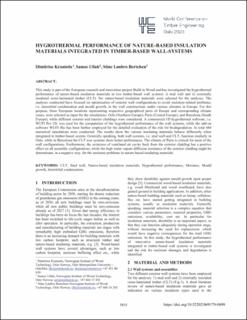| dc.description.abstract | This study is part of the European research and innovation project Build in Wood and has investigated the hygrothermal performance of nature-based insulation materials in two timber-based wall systems: i) stud wall and ii) externally insulated cross-laminated timber (CLT). Six nature-based insulation materials were selected for the analyses. The analyses conducted have focused on optimization of exterior wall configurations to avoid moisture-related problems, i.e. interstitial condensation and mould growth, in the wall constructions under various climates in Europe. For this purpose, three European locations representing respective geographical parts of Europe and corresponding climate zones, were selected as input for the simulations: Oslo (Northern Europe), Paris (Central Europe), and Barcelona (South Europe), while different exterior and interior claddings were considered. A commercial 1D hygrothermal software, i.e. WUFI Pro 1D, was used for the computation of the hygrothermal performance of the wall systems, while the add-on software WUFI Bio has been further employed for the detailed evaluation of the risk for biodegradation. In total 684 numerical simulations were conducted. The results show the various insulating materials behave differently when integrated in timber-based system. Generally speaking, both wall systems, i.e. stud wall and CLT, function similarly in Oslo, while in Barcelona the CLT was systems show better performance. The climate of Paris is critical for most of the wall configurations. Furthermore, the existence of ventilated air cavity back from the exterior cladding has a positive effect on all assembly configurations, while the high water vapour diffusion resistance of the exterior cladding might be determinant, in a negative way, for the moisture problems in nature-based insulating materials. | en_US |
